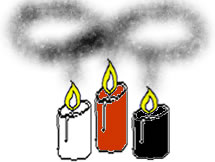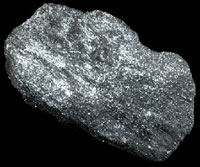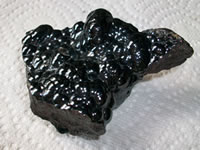
Botryoidal

Needle
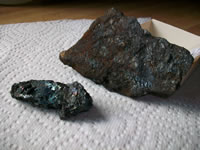
Irridescent

Blade / Plate
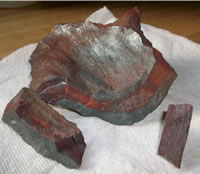
Jaspilite / Banded Iron
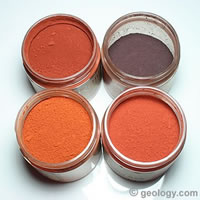
Hematite pigments
|
Hematite FE2 O3
Iron with
impurities
Hardness: 5-6
Streak: red to red-brown
Color: black, metallic grey, can oxidize to red
AKA: iron oxide, haematite,
Hematite
is a form of iron, as anyone can tell who has lifted a piece of it.
It rarely occures as pure iron, which is why it is not magnetized. Kidney
ore, or botryoidal, is the most pure form. The specular hematite found
in the UP has impurities, sometimes includes magnetite which is why
people have the false impression it is magnetic (see my info on specular
hematite below).
"Pure
hematite has a composition of about 70% iron and 30% oxygen by weight.
Like most natural materials, it is rarely found with that pure composition.
This is particularly true of the sedimentary deposits where hematite
forms by inorganic or biological precipitation in a body of water.
Minor clastic sedimentation can add clay minerals to the iron oxide.
Episodic sedimentation can cause the deposit to have alternating bands
of iron oxide and shale. Silica in the form of jasper, chert, or chalcedony
can be added by chemical, clastic, or biological processes in small
amounts or in significant episodes. These layered deposits of hematite
and shale or hematite and silica have become known as the "banded
iron formations" -- from geology.com
Hematite is unique
in that it forms in a varity of shapes. I have been collecting it in
all its forms, see pictures to the left. Most have seen it as botryoidal,
those of us in Michigan have seen specular. When it occurs as plates
it will form roses. There is also needle or pencil, irridescent, and
actual crystals.
"Crystals
occurs in thin plates, as well as bundles of small micaceous plates,
and in thin splinters. Most commonly massive, mammilary, botryoidal,
reniform, oolitic, stalactitic, and radiating. Scalenohedral and rhombohedral
crystals occur, as well as tabular and groups of tabular crystals.
Crystals are often striated. Dendritic and rosette forms are also
found. May form as a pseudomorph after other minerals, especially
as octahedral crystals of Magnetite." - geology.com
Sidenote:
in geology, they describe the 'crystal habit' of stones. A crystal
habit is an external shape displayed by an individual crystal, influenced
by the atomic structure of the crystal growth. So in the above quote,
'crystal' does not mean a crystal like quartz.
Hematite is an iron
ore. And is mined for that reason. But as it is not pure iron, it has
other uses. The hematite we see most often is black or silver, but it
can occur red in color. And when you crush the black or silver, the
dust often is red. Hematite used to be called bloodstone, as when it
was grinded or polished, the water would run red.
Uses of Hematite
(Pigment) :
The name hematite is from the Greek word "haimatitis" which
means "blood-red." That name stems from the color of hematite
when it has been crushed to a fine powder. Primitive people discovered
that hematite could be crushed and mixed with a liquid for use as
a paint or cosmetic. Cave paintings, known as "pictographs,"
dating back to 40,000 years ago were created with hematite pigments.
Hematite continues to be one of the most important pigment minerals.
It has been mined at many locations around the world and has been
traded extensively as a red pigment. During the Renaissance when many
painters began using oils and canvas, hematite was one of the most
important pigments. Hematite color was opaque and permanent. It could
be mixed with a white pigment to produce a variety of pink colors
that were used to paint flesh.
It is a very dense and inexpensive material that is effective at stopping
x-rays. For that reason it is used for radiation shielding around
medical and scientific equipment. The low cost and high density of
hematite and other iron ores also makes them useful as ballast for
ships.
hematite is the material used to make polishing compounds known as
"red rouge" and "jeweler's rouge." Red rouge is
a hematite powder used to polish brass and other soft metals. It can
be added to crushed corn cob media or crushed walnut shell media for
tumble-polishing brass shell casings. Jeweler's rouge is a paste used
on a soft cloth to polish gold and silver jewelry. -- geology.com
As stated above,
it stops x-rays and radiation. This includes the electromagnetic field
from cell phones, wi-fi, ect. I have pieces around my house to block
the signal of the Smart Meters, and by my computer and wi-fi.
Hematite makes beautiful
jewelry, although not all beads and pendants are formed from the stone.
some are manmade to look like hematite, often including some hematite
mixed with other materials. Try a streak test, rub it across an unglazed
tile. If the streak has any red in it, then it is hematite.
So how was hematite
formed and where is it found? Answers below.
Geologic
Occurrence:
"Hematite is found as a primary mineral and as an alteration
product in igneous, metamorphic, and sedimentary rocks. It can crystallize
during the differentiation of a magma or precipitate from hydrothermal
fluids moving through a rock mass. It can also form during contact
metamorphism when hot magmas react with adjacent rocks.
The most important hematite deposits formed in sedimentary environments.
About 2.4 billion years ago, Earth's oceans were rich in dissolved
iron, but very little free oxygen was present in the water. Then a
group of cyanobacteria became capable of photosynthesis. The bacteria
used sunlight as an energy source to convert carbon dioxide and water
into carbohydrates, oxygen, and water. This reaction released the
first free oxygen into the ocean environment. The new oxygen immediately
combined with the iron to form hematite, which sank to the bottom
of the seafloor and became the rock units that we know today as the
banded iron formations.
Soon, photosynthesis was occurring in many parts of Earth's oceans,
and extensive hematite deposits were accumulating on the seafloor.
This deposition continued for hundreds of millions of years - from
about 2.4 to 1.8 million years ago. This allowed the formation of
iron deposits hundreds to several thousand feet thick that are laterally
persistent over hundreds to thousands of square miles. They comprise
some of the largest rock formations in Earth's rock record.
Many of the sedimentary iron deposits contain both hematite and magnetite
as well as other iron minerals. These are often in intimate association,
and the ore is mined, crushed, and processed to recover both minerals.
Historically, much of the hematite was not recovered and was sent
to tailings piles. More efficient processing today allows more hematite
to be recovered from the ore. The tailings can also be reprocessed
to recover additional iron and reduce tailings volume." --Geology.com
"Locations:
Hematite has numerous good localities, and therefore only the finest
will be mentioned. Large and thick crystals have been found in Minas
Gerais, Brazil, particularly at Antonio Pereira, Congonhas de Campo,
Jaguaracu, and Itabira. Lustrous plates with flat or tabular crystals
come from Novo Horizonte and Brumado, Bahia, Brazil. Most of the tumbled,
polished Hematite comes from Minas Gerais.
Cumberland,
in Cumbria, England, is a major source of Hematite specimens, especially
the Specularite variety, as well as much of the globular and stalactitic
specimens. Another classic occurrence is Rio Marina, on the island
of Elba, Italy. The Cavradi Gorge in Tujetsch, Grischun, Switzerland
is well-known for its outstanding and unique lustrous tabular Hematite
crystals.
Morocco has
also been a recent producer of fine collectible Hematite, with special
note on Nador in the Nador Province, where excellent crystals and
clusters have been found. The Wessels Mine in Hotazel, in the Kalahari
manganese fields of South Africa has produced outstanding lustrous
crystals including the rare prismatic forms.
In the U.S.,
enormous Hematite deposits exists throughout the western area of Lake
Superior, especially in the Menominee iron range, Iron Co., Michigan.
"Iron Roses" occur in the Thomas Range in Utah, as well
as in numerous localities in Arizona, namely Aztec Peak, Gila Co.;
Bouse, Yuma Co.; and in the Buckskin Mountains in La Paz Co. A classic
New York locality is Chub Lake, St. Lawrence Co". -- minerals.net
|
|
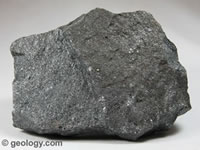
Magnetite
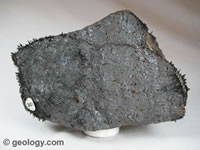
Lodestone
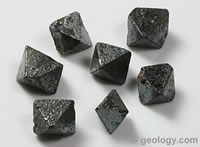
Lodestone Crystals
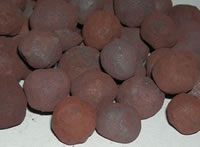
Taconite Pellets
pic from geology.com
|
Magnetite FE3 O4
Purest iron
Hardness: 5-6
Streak: black
Color: black, grey, metalic
AKA: lodestone
Because they are
both iron ore, hematite and magnetite look identical with one big difference:
magnetisim. Magnetite is best known for its property of being strongly
attracted to magnets. Some forms of magnetite from specific localities
are in fact themselves magnets. Commonly known as Lodestone,
this magnetic form of magnetite is the only mineral that is a natural
magnet. Due to the magnetism of lodestone, small iron particles are
often found clinging to its surfaces. (Some dealers may even intentionally
place metallic filings on a lodestone to demonstrate its magnetism.)
"When
the earth formed, the heavier metals, such as iron, were pulled by
gravity into the planet's core, where the Earth's magnetic field is
generated. The earliest compasses had pieces of magnetite.
Although magnetite contains a higher percentage of iron and is easier
to process, hematite is the leading ore because it is more abundant
and present in deposits in many parts of the world." --geology.com
Both hematite and
magnetite are often found banded with other materials, such as chert
or quartz. Some of the pieces I brought back from the UP are like this,
a magnet will stick to only one band on the rock. I found out that this
combination is called taconite, but sadly is being crusted
so that the iron ore can be used.
"Most
of the iron ore mined today is a banded sedimentary rock known as
taconite that contains a mixture of magnetite, hematite, and chert.
Once considered a waste material, taconite became an important ore
after higher grade deposits were depleted. Today's commercial taconites
contain 25 to 30% iron by weight.
At the mine site, the taconite ore is ground to a fine powder, and
strong magnets are used to separate magnetically susceptible particles
containing magnetite and hematite from the chert. The concentrate
is then mixed with small amounts of limestone and clay, then rolled
into small round pellets. These pellets are easy to handle and transport
by ship, rail, or truck. They can be directly loaded into a blast
furnace at a mill and be used to produce iron or steel." --Geology.com
"Uses:
The abrasive known as "emery" is a natural mixture of magnetite
and corundum. Some synthetic emery is produced by mixing magnetite
with aluminum oxide particles. The production of synthetic emery gives
the manufacturer control over the particle size and the relative abundance
of aluminum oxide and magnetite in the product. Some finely ground
magnetite is also used as an abrasive in waterjet cutting. In the
past few decades, synthetic abrasives have filled many of the applications
where magnetite was previously used.
Small amounts of magnetite are also used as a toner in electrophotography,
as a micronutrient in fertilizers, as a pigment in paints, and as
an aggregate in high-density concrete". -geologyl.com
Metaphysical Properties:
Helps remain in harmony with the planet.
Help avoid loss of direction, find the right path
Best at neutralizing the environmental pollution of modern urban living
Turn bad situations around
Aligns chakras. Realigns body with electromagnetic field of the planet
Releases stress, grounds, and energizes.
|
|
